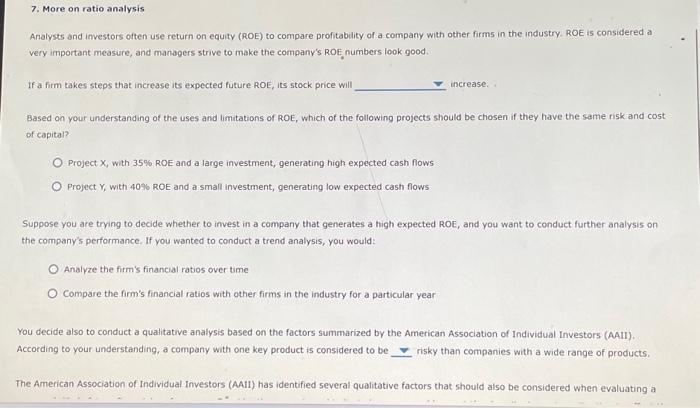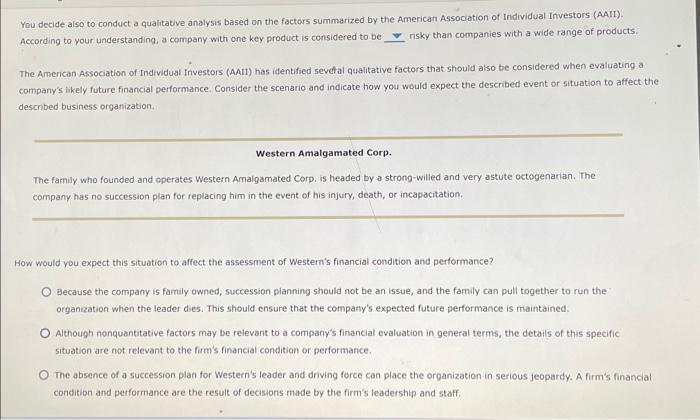Analysts and investors often use return on equity (ROE) to compare profitability of a company with other firms in the industry. ROE is considered a very important measure, and managers strive to make the company's ROE numbers look good. If a firm takes steps that increase its expected future ROE, its stock price will increase. Based on your understanding of the uses and limitations of ROE, which of the following projects should be chosen if they have the same risk and cost of capital? Project X, with 35% ROE and a large investment, generating high expected cash flows Project Y, with 40% ROE and a small investment, generating low expected cash flows Suppose you are trying to decide whether to invest in a company that generates a high expected ROE, and you want to conduct further analysis on the company's performance, If you wanted to conduct a trend analysis, you would: Analyze the firm's financial ratios over time Compare the firm's financial ratios with other firms in the industry for a particular year You decide also to conduct a qualitative analysis based on the factors summarized by the American Association of Individual Investors (AAII). According to your understanding, a company with one key product is considered to be risky than companies with a wide range of products. The American Association of Individual Investors (AAil) has identified several qualitative factors that should aiso be considered when evaluating a You decide also to conduct a qualitative analysis based on the factors summarized by the American Association of Individual Investors (AAII). According to your understanding, a company with one key product is considered to be risky than companies with a wide range of products. The Amencan Association of Individual Investors (AAII) has identified sevelal qualitative factors that should also be considered when evaluating a company's likely future financial performance. Consider the scenario and indicate how you would expect the described event or situation to affect the described business organization. Western Amalgamated Corp. The family who founded and operates Western Amaigamated Corp. is headed by a strong-willed and very astute octogenarian. The company has no succession plan for replacing him in the event of his injury, death, or incapacitation. How would you expect this situation to affect the assessment of Western's financial condition and performance? Because the company is family owned, succession planning should not be an issue, and the family can pull together to run the organization when the leader dies. This should ensure that the company's expected future performance is maintained. Although nonquantitative factors may be relevant to a company's financial evaluation in general terms, the details of this specific situation are not relevant to the firm's financial condition or performance. The absence of a succession plan for Western's leader and driving force can place the organization in serious jeopardy. A firm's financial condition and performance are the result of decisions made by the firm's leadership and staff. Analysts and investors often use return on equity (ROE) to compare profitability of a company with other firms in the industry. ROE is considered a very important measure, and managers strive to make the company's ROE numbers look good. If a firm takes steps that increase its expected future ROE, its stock price will increase. Based on your understanding of the uses and limitations of ROE, which of the following projects should be chosen if they have the same risk and cost of capital? Project X, with 35% ROE and a large investment, generating high expected cash flows Project Y, with 40% ROE and a small investment, generating low expected cash flows Suppose you are trying to decide whether to invest in a company that generates a high expected ROE, and you want to conduct further analysis on the company's performance, If you wanted to conduct a trend analysis, you would: Analyze the firm's financial ratios over time Compare the firm's financial ratios with other firms in the industry for a particular year You decide also to conduct a qualitative analysis based on the factors summarized by the American Association of Individual Investors (AAII). According to your understanding, a company with one key product is considered to be risky than companies with a wide range of products. The American Association of Individual Investors (AAil) has identified several qualitative factors that should aiso be considered when evaluating a You decide also to conduct a qualitative analysis based on the factors summarized by the American Association of Individual Investors (AAII). According to your understanding, a company with one key product is considered to be risky than companies with a wide range of products. The Amencan Association of Individual Investors (AAII) has identified sevelal qualitative factors that should also be considered when evaluating a company's likely future financial performance. Consider the scenario and indicate how you would expect the described event or situation to affect the described business organization. Western Amalgamated Corp. The family who founded and operates Western Amaigamated Corp. is headed by a strong-willed and very astute octogenarian. The company has no succession plan for replacing him in the event of his injury, death, or incapacitation. How would you expect this situation to affect the assessment of Western's financial condition and performance? Because the company is family owned, succession planning should not be an issue, and the family can pull together to run the organization when the leader dies. This should ensure that the company's expected future performance is maintained. Although nonquantitative factors may be relevant to a company's financial evaluation in general terms, the details of this specific situation are not relevant to the firm's financial condition or performance. The absence of a succession plan for Western's leader and driving force can place the organization in serious jeopardy. A firm's financial condition and performance are the result of decisions made by the firm's leadership and staff








